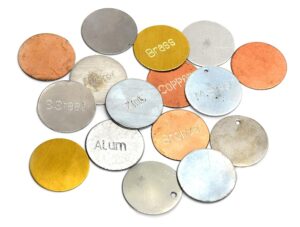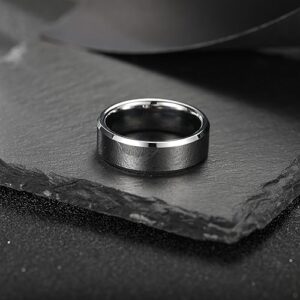Ever looked at a shiny ring or necklace and wondered, “Is this white gold or silver?”
You’re not alone — they look so alike, it’s easy to mix them up.
But here’s the thing: they’re actually very different.
From price and durability to how they age and feel on your skin — knowing the difference can save you money and stress.
So whether you’re buying a gift or something for yourself, let’s quickly clear up the confusion — in a way that’s simple and helpful.
Table of Contents
What Is White Gold?
White gold may look like silver at first, but its story starts with yellow gold. It’s created by mixing yellow gold with white metals like nickel or palladium, which gives it extra strength and a cooler, silvery tone.
Once shaped, white gold is coated with a thin layer of rhodium—a rare metal that adds a bright, mirror-like shine and helps protect against scratches. Over time, this coating can wear off, revealing a slightly yellowish tint underneath.
You’ll often see markings like 14k or 18k on white gold jewelry. 14k (58.5% gold) is more durable and ideal for daily wear, while 18k (75% gold) is richer in gold content but softer and more luxurious.
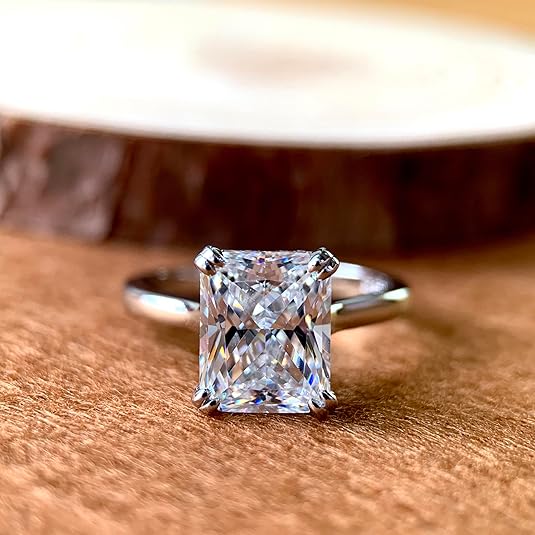
What Is Sterling Silver?
Sterling silver is 92.5% pure silver mixed with 7.5% other metals (usually copper) to make it stronger. It has a warm, natural shine and doesn’t need any coating.
Silver is affordable and popular for all kinds of jewelry. But it can tarnish, meaning it darkens when exposed to air or chemicals. Don’t worry—tarnish is easy to clean, and wearing silver often actually helps keep it shiny.
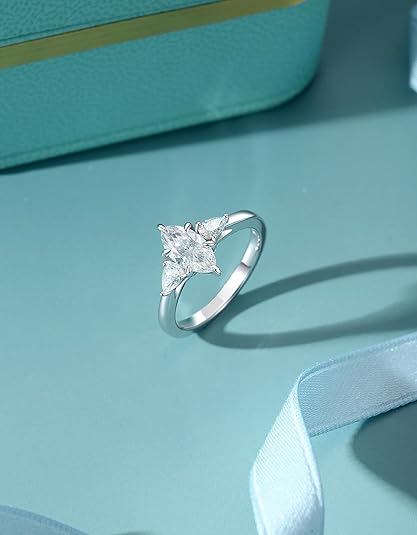
White Gold vs Silver
White gold and sterling silver may look alike, but they differ in many ways. Let’s break down the key differences to help you choose the metal that truly matches your style, needs, and lifestyle.
Stamp Markings(Hallmarks)
- White gold jewelry is usually stamped with marks like “14K” or “18K”, showing its gold content.
- Sterling silver will be marked with “925” or the word “STERLING,” meaning it’s 92.5% pure silver.
Color and Shine
- White Gold has a bright, mirror-like shine due to its rhodium coating, giving it a cool, modern appearance.
- Sterling Silver has a warm-white tone with a softer, more understated glow.
Durability
- White Gold is tougher and more scratch-resistant. For example, a 14K white gold ring can handle daily wear without getting damaged easily.
- Sterling Silver is softer and scratches more easily. If you wear it every day, you might see small scratches or dents over time.
Price
- White Gold is more expensive due to the gold content and plating process. For example, a white gold necklace might cost $500 or more.
- Sterling Silver is budget-friendly. You can find sterling silver jewelry for under $100 that still looks great.
Weight
- White gold feels heavier and denser in your hand, giving it a more solid, luxurious feel.
- Sterling silver is lighter, which can make it more comfortable for larger or statement pieces.
Care and Maintenance
- White Gold needs rhodium plating every 1 to 2 years to keep its bright white shine. Without plating, it may turn a little yellowish.
- Sterling Silver doesn’t need plating but will tarnish. You can fix tarnish by polishing it with a cloth or silver cleaner.
Tarnish Resistance
- White Gold doesn’t tarnish because of its rhodium coating.
- Sterling Silver tarnishes easily when exposed to air, moisture, or chemicals like perfume or chlorine. But the tarnish can be cleaned off.
Allergy Risk
- White Gold may contain nickel, which can cause allergies or skin irritation in some people. If you’re allergic, look for “nickel-free” white gold or palladium white gold.
- Sterling Silver is usually safe for sensitive skin, especially if it’s labeled “nickel-free.”
Style Appeal
- White Gold has a sleek, luxury look, perfect for formal occasions or special gifts.
- Sterling Silver has a more casual, everyday vibe. It fits well with vintage, boho, or minimalist styles.
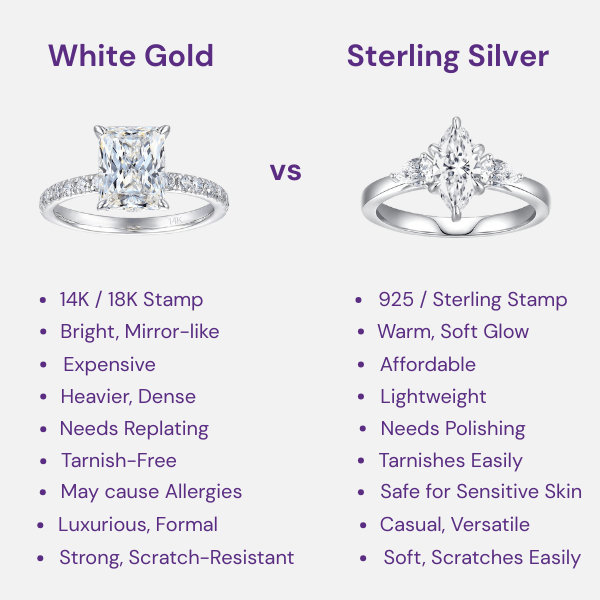
Which Metal Fits You Best?
Choosing between white gold and sterling silver can be tricky, but asking yourself a few quick questions can make it much easier.
Start by thinking about your budget—if you’re on a tight budget (under $100), sterling silver is a great, affordable option. If you have a bit more to spend, white gold offers a more luxurious, durable choice.
Next, consider your color preference: if you love bright, shiny, cool tones, white gold with its rhodium plating will suit you best. If you prefer softer, warmer tones, sterling silver might be the way to go.
Finally, think about how often you wear your jewelry. For everyday durability, white gold is a smart pick, while sterling silver works well for occasional or casual wear. This quick questions helps you focus on what matters most—style, budget, and lifestyle—so you can confidently choose jewelry that fits you perfectly.
Pros and Cons of White Gold and Sterling Silver
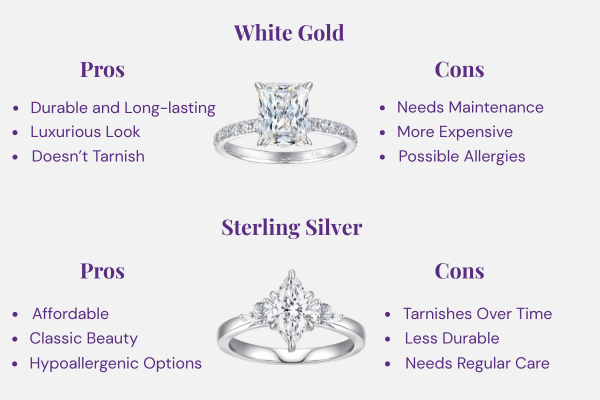
Frequently Asked Question's
White gold is better than silver if you want a more durable, long-lasting, and luxurious metal. It resists scratches and tarnish better, making it ideal for everyday wear and fine jewelry. However, silver is a great choice if you’re looking for something more affordable with a soft, classic look. So, the “better” option depends on your budget and how you plan to wear it.
White gold lasts longer because it’s stronger and coated with rhodium, which protects it. Silver can tarnish and scratches more easily.
Yes, silver tarnishes easily when exposed to air, moisture, or chemicals like perfume and chlorine. However, the tarnish can be cleaned, and wearing silver regularly actually helps slow it down.
Yes, silver can be used for wedding rings, but it’s softer and may wear down faster with daily use compared to white gold or other metals.
Yes, white gold is great for everyday wear because it’s strong and scratch-resistant, especially 14K white gold. Just remember it may need rhodium plating every couple of years to keep its shine.
Final Words
If you want durable jewelry for everyday wear that looks luxurious, white gold might be your best choice. If you’re after affordable, stylish pieces that you can mix and match for casual or special occasions, sterling silver is a fantastic pick.
And remember, both metals have their own charm — it’s about what fits your budget, lifestyle, and personal taste.
Which one do you prefer — white gold or sterling silver?
Share your thoughts in the comments below — I’d love to hear what you think!

